Visit Bucharest
Old City Center
Located in the heart of the city, the old Bucharest is a remainder of the times when the city used to be nicknamed "little Paris". Here visitors can choose to walk through the The Old Merchant Lipscani Street, which consists of a jumble of streets between Calea Victoriei, Blvd. Bratianu, Blvd. Regina Elisabeta and the Dambovita River. A once-glamorous residential area, the old city centre is now slowly being refashioned into an upscale neighborhood. Today, the area is home to many art galleries, antique shops and coffeehouses. At the centre of the historic area can be found the remains of the Old Princely Court (Curtea Veche), built in the 15th century by Vlad Tepes, also known as Vlad Dracula. The Old Court Museum was established in 1972 when an archaeological dig revealed the remains of the fortress, along with Dacian pottery and Roman coins, evidence of Bucharest's earliest inhabitants. The oldest document attesting to the city's origin under the name of Bucuresti (Bucharest) was discovered here. It was issued on September 20, 1459 and signed by Prince Vlad Tepes. Next to the palace stands the Old Court Church (Biserica Curtea Veche), dating from 1559 and considered the oldest in Bucharest. For two centuries, the church served as coronation ground for Romanian princes. Some of the original 16th century frescoes have been preserved. Manuc's Inn (Hanul lui Manuc) can also be found here.The Inn was built between 1804 and 1808 and has was witness in 1812 to the preliminary talks of the Peace Treaty that put an end to the Russian -Turkish War (1806-1812). A favorite meeting and resting place for tradesmen in those times, Manuc's Inn has preserved to this day its old style and flavor. It now serves as a hotel with a restaurant, a wine cellar and a pastry shop. For a good lunch or dinner in the Old City Center, the Beer Cart Restaurant (Carul cu Bere) is well recommended. The restaurant opened in 1879 and soon became one of the most popular meeting places for Bucharest's literati who would gather to discuss matters of their time. Its neo-gothic architectural style is reflected both in the façades and the interior decorations: columns, arches, chandeliers, a wooden staircase, furniture and murals on the walls and ceiling.
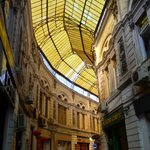
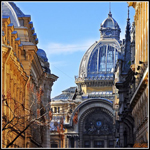
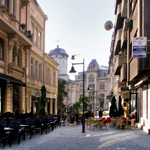
Monuments
Revolution Square (Piața Revoluției)
The square gained worldwide notoriety when TV stations around the globe broadcasted Nicolae Ceausescu's final moments in power on December 21, 1989. It was here, at the balcony of the former Communist Party Headquarters, that Ceausescu stared in disbelief as the people gathered in the square below turned on him.
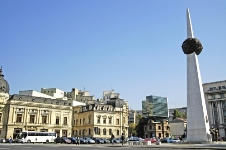
The Arch of Triumph (Arcul de Triumf)
Initially built of wood in 1922 to honor the bravery of Romanian soldiers who fought in World War I, Bucharest's very own Arc de Triomphe was finished in 1936. Designed by the architect, Petre Antonescu, the Arc stands 85 feet high. An interior staircase allows visitors to climb to the top for a panoramic view of the city.

Parliament Palace (Palatul Parlamentului)
Built by Communist Party leader, Nicolae Ceausescu, the colossal Parliament Palace (formerly known as the People's Palace) is the second largest administrative building in the world after the Pentagon.It took 20,000 Bucharest - Parliament Palace workers and 700 architects to build. The palace boasts 12 stories, 1,100 rooms, a 328-ft-long lobby and four underground levels, including an enormous nuclear bunker.
When construction started in 1984, the dictator intended it to be the headquarters of his government. Today, it houses Romania's Parliament and serves as an international conference centre. Built and furnished exclusively with Romanian materials, the building reflects the work of the country's best artisans. A guided tour takes visitors through a small section of dazzling rooms, huge halls and quarters used by the Senate (when not in session). The interior is a luxurious display of crystal chandeliers, mosaics, oak paneling, marble, gold leaf, stained-glass windows and floors covered in rich carpets.
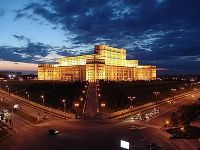
Parks
Cismigiu Garden (Gradina Cismigiu)
Address: Blvd. Regina Elisabeta (across from Bucharest City Hall)
Designed in 1845 by the German landscape architect Carl Meyer, Cismigiu is Buchares’t oldes park opened to the public in 1860. The name, Cismigiu, comes from the Turkish cismea, meaning "public fountain."
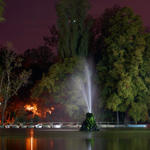
Herastrau Park (Parcul Herastrau)
Address: Sos. Kiseleff 32
Spread over some 400 acres, from the Arch of Triumph to the Baneasa Bridge, the park is home to numerous attractions, including a boat rental complex, tennis courts, and a rather old-fashioned fairground. In the summertime, many terraces open up on the shores of the lake. For an overview of the park, take a ride around the lake on the ferry or rent your own boat. The park is also home to the Village Museum. The area surrounding the park holds even greater treasures. The streets between Bulevardul Mircea Eliade and Soseaua Kisileff contain extraordinarily beautiful houses in architectural styles ranging from 19th century neoclassical to 20th century art nouveau and modern luxury villas. This is where Bucharest's elite once lived - and still do today.
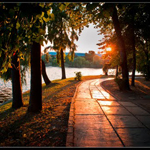
Carol I Park (Parcul Carol I)
Address: Calea Serban Voda
This large park is one of the most beautiful in the city and contains a massive monument that once housed the remains of communist leader Gheorge Gheorgiu Dej, as well as the eternal flame that marks the grave of the Unknown Soldier. Designed by French landscape architect Eduard Redont in 1900s, the park offers pleasant walks down tree-lined paths, a good view of central Bucharest (from the monument) and plenty of photo opportunities. In summertime, the park's Arenele Romane is the stage for open-air concerts.

Botanical Garden
Address: Sos. Cotroceni 32 (across from Cotroceni Palace)
Opened in 1891, the garden features over 5,000 varieties of plants from Romania and around the world. The garden also encompasses a beautiful building in the Brancovenesc architectural style, housing the Botanical Garden Museum. Here, you can peruse manuscripts, old botanical research devices and a collection of artifacts made of vegetal materials. Locals treat the gardens as a park, and on warm afternoons, you may see more young lovers than plants. The huge greenhouses are open Tue, Thu, Sat, Sun, 9am - 1pm.
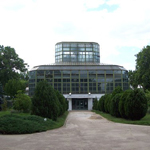
Museums
National Art Museum placed in the former Royal Palace hosts three art galleries and has a short, but impressive royal past. The European Art Gallery, the Romanian Medieval Art Gallery and the Romanian Modern Art Gallery bring together art works exhibited in an attractive, modern manner, thus turning a visit to the museum into an enjoyable and instructive way of spending time.

Village Museum is an open-air ethnographical museum that borders Herastrau Park. Opened in 1936, the museum contains a collection of over 300 structures from all over Romania including different styles of houses, windmills, barns, windmills, fisheries, churches and even an old merry go round. They were brought from all over Romania, reassembled bit by bit in the park, and clustered and arranged so as to show the real pattern of Romanian villages, with little winding paths between them.
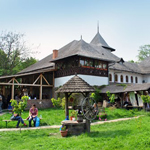
The National Museum of Romanian History is one of the most important museums. The museum contains Romanian historical artifacts from prehistoric times up to modern times; the permanent displays include a plaster cast of the entirety of Trajan's Column, the Romanian Crown Jewels, and the Pietroasele treasure.

The National Museum of Contemporary Art is Bucharest’s newest museum, that displays works of Romania's contemporary artists as well as many temporary exhibits by international artists. The museum is housed in a wing of the Palace of Parliament, the space which would have served as Nicolae and Ileana Ceausescu's private apartment (where just the bathroom occupied 680 square feet, while the adjoining boudoir was three times that size).

Bucharest - Hop On/ Off Sightseeing Bus Tours
Hop-on, hop-off bus tours are operated daily on a fleet of new double-decker buses. Travelers can get an introduction to Bucharest's fascinating architectural mix and get familiar with the city's central neighborhoods and places of interest in less than one hour.
Fast Facts Hours of operation: 10 am - 10 pm
Frequency: every 15 minutes
Total length of the route: 9.5 miles
Number of stops: 14 (see/print map)

For more information please visit the official Romanian Tourism’ website:
http://www.romaniatourism.com/bucharest.html








